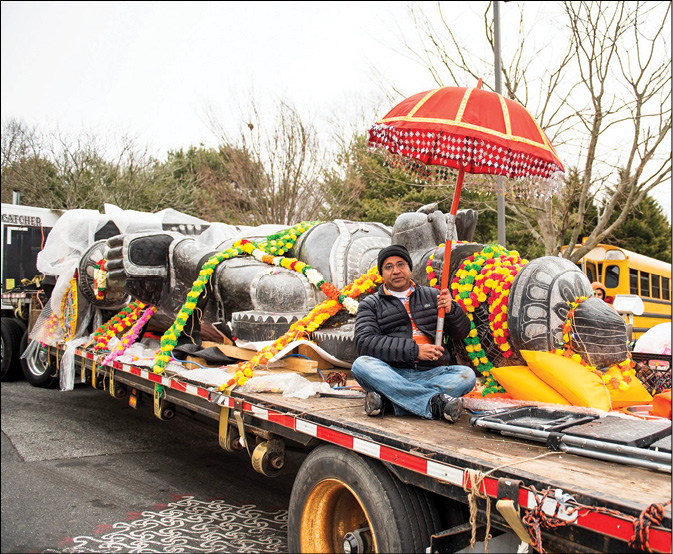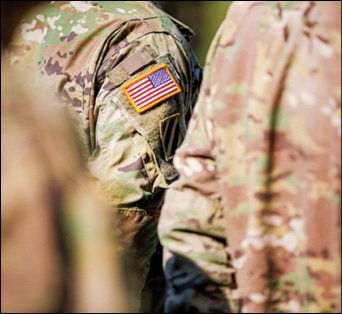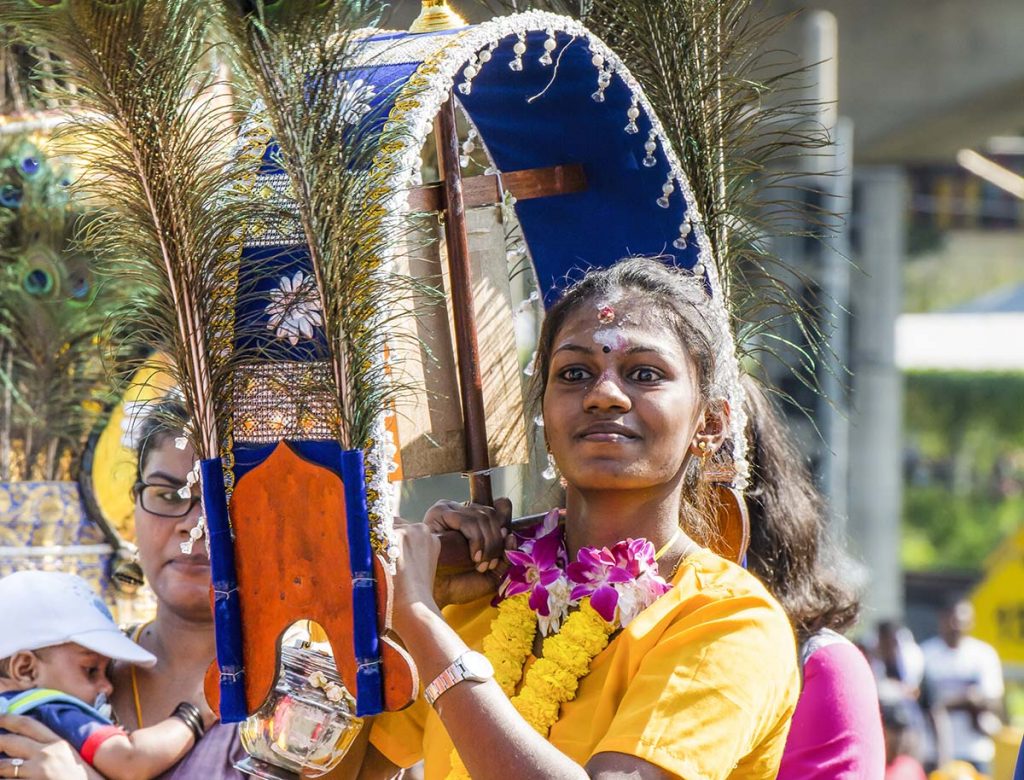HEALTH
Is Kavadi Good for You?
A RECENT STUDY PUBLISHED IN Current Anthropology examines the physical and psychological effects of the performance of kavadi attam. Kavadi, most commonly demonstrated during Lord Murugan’s festival of Thai Pusam, is practiced by millions of Hindus around the world.
The name comes from kaavu and tadi, which refer to a pole to carry heavy things. Devotees carry heavy, elaborately decorated arches or altars on their shoulders, usually with milk pots attached to them. Kavadi bearers dance for hours as a form of devotion, personal sacrifice and/or penance as they pilgrimage to their temple. Often piercings through the skin or tongue are used, upon which objects are attached or hung.
The study took place in Quatre Bornes, Mauritius, and included 37 individuals from the local community. Participants were thoroughly monitored weeks before and after the event in the areas of stress, sleep, physical activity, heart rate and more, while also taking into account other environmental factors in their lives, such as socio-economic status.
Results showed that participants experienced positive effects on psychological well-being and had no negative effects to their physiological health. Those who engaged in a higher number of body piercings showed the greatest improvements in quality of life, and people who had been experiencing health issues or were of low economic status showed higher levels of engagement. Researchers cite many reasons for the positive effects that were observed, including community bonding and the brain’s euphoric, neurochemical reactions to physical and sensory stress.
USA
Hanuman Arrives in Delaware
IN JANUARY 2020, HINDUS AND COMMUNITY MEMBERS GATHERED at the Hindu Temple of Delaware in Hockessin to greet the tallest Hanuman statue in the United States. Towering 25 feet, the 60,000-pound granite murti took over a year to carve in Telangana, India. He arrived at the temple on a flatbed truck accompanied by a motorcade of ten Department of Transportation trucks, six county patrol cars, three mounted horse patrol units and nearly 100 other vehicles. He was welcomed by crowds of devotees with beating drums, fireworks and songs.
Hanuman’s formal installation at the temple is scheduled for May of this year. He joins several other prominent Hanuman statues in North America, including the 50-foot-tall Hanuman at the Richmond Hill Vishnu Mandir in Ontario, Canada, and the 21-foot-tall statue at the Hanuman Mandir of Greater Chicago in Illinois. There’s also a 85-foot one in Trinidad. This Hanuman is unique in that He is entirely black granite—a hard stone with delicate tensile strength. He is a true celebration of Indian craftsmanship and carving skill.

USA
Bronze Lord Hanuman Stands in Hawaii

FOR THE FIRST TIME, A MASTERFULLY crafted, 13-foot-tall image of Lord Hanuman has been installed in Hawaii, USA. At 1:31pm on Friday, January 25, 2019, Lord Hanuman’s feet touched down on a small hill near the sacred rudraksha forest at Kauai Aadheenam (home of HINDUISM TODAY), where it is planned that He stand firm for a thousand years. This concluded a more than ten-year long project set in motion by the late Gurudeva Sivaya Subramuniyaswami.
Decades ago Gurudeva had a powerful vision of Hanuman, and realized it was Hanuman’s strength that would bring the currently-under-construction Iraivan Temple from India to Kauai, stone by stone.
Indian artisans were commissioned to design and carve a large granite murti of the God, temple in hand; and after many years of work, the granite version of Hanuman was shipped to Kauai. However, the granite cracked some time after its arrival. At that point, Hawaii’s master sculptor Holly Young was commissioned to make molds of the statue and add extra details to create a more elegant bronze version of the original. Her molds went to Page Bronze of Colorado, USA, to be cast and completed. Hanuman was given a green-jade patina added by Patrick Kipper, one of the United States’ most renowned patineurs. The result was one of the most exquisite Hanuman statues of this size and material produced in the Western Hemisphere—acknowledging the fact that He was originally designed and carved in India.
After He was set in place by crane, the harnesses were removed and He was draped with a shawl and given offerings of incense, fruits, coconuts, flowers and an arati.
INDIA
A Temple for Shri Ram?
ON NOVEMBER 9, 2019, AN Indian Supreme Court ruling finally resolved the deeply polarizing and destabilizing dispute over the Ram Janmabhoomi-Babri Masjid. The location where the building stands today has long been considered the birthplace of Lord Ram. The mosque was constructed in the early 1500s by Emperor Babar of the Mughal Empire, after dismantling the existing temple. Since the 1800s the mosque land has been under legal dispute. In 2010 a court judgment partitioned the disputed property between Hindu and Muslims. After another decade of appeals and court hearings, a Constitution Bench of five judges ruled that a Ram temple may be constructed at the disputed site, while the government must provide Muslims with five acres of prominent land in Ayodhya.

USA
Military Severely Lacking in Hindu Chaplains
SINCE ITS INCEPTION, THE United States has employed clergy to minister to soldiers. As the nation’s diversity grew over the centuries, its military has been pressed to meet the needs of service members with a variety of religious backgrounds. Chaplains provide counseling, train with soldiers and are deployed to war zones, but do not carry weapons.
In 2017 the US Defense Department expanded its list of recognized religions from 100 to 221, which includes major faiths as well as less common belief systems such Shamanism, Odinism (Asatru) and Druidism. This tasks the US military with finding theologically learned members of these faiths when needed. Following Pratima Dharm’s retirement from service, Hinduism currently has no US chaplains in the military.

At the recent 2019 Hindu Mandir Executive Conference in New Jersey, a US army chaplain recruiter told HINDUISM TODAY of the challenge faced by the US Chaplaincy program in finding chaplains for their Hindu soldiers. He hopes that any religiously astute Hindus joining the armed forces will seriously consider becoming a chaplain, in order to respond to this growing and unfulfilled need.
INDIA
Have Scientists Found the Great Sarasvati River?
THE GHAGGAR RIVER IS A SEASONAL, monsoon-fed waterway in India and Pakistan, originating in the sub-Himalayas. According to a study published in Scientific Reports, researchers from the Physical Research Laboratory in Ahmedabad and the Indian Institute of Technology Bombay have analyzed multiple substrate samples taken from between 3-10 meters below the surface of the river. They found it was previously a perennial river, and that some 80,000 to 20,000 years ago it was receiving sediments from the Higher Himalayas. Between 9,000 and 4,500 years ago, it was receiving sediment from the lower Himalayas and was also connected to incoming waters from the nearby Sutlej River. This means that during the early Harappan civilization, the river was still perennial.
According to the authors of the paper, such unambiguous evidence of the river’s perennial past means that it could easily be the remains of the Sarasvati River, oft-mentioned in the Rig Veda. This theory has been postulated many times before, but without ample evidence of the continuous, 3-mile wide mighty water flow described in the Rig.
The discovery also sheds light on the long-standing mystery as to why so many Harappan settlements can be found all along the modern-day Ghaggar Hakra stream. Archeological evidence shows that, unlike more arid settlements in the Kachchh regions, these settlements would not have required rainwater collection which would have been needed if the river had been seasonal as it is today.

BOOKS
Vedas and Upanishads for Kids
ROOPA PAI IS A COMPUTER engineer from Bengaluru with a penchant for Hindu philosphy and Indian mythology. As an accomplished writer of children’s books, she took on the challenge of writing The Gita for Children, which would go on to sell over 75,000 copies. After that success, she gave herself the daunting task of creating The Vedas and Upanishads for Children, a project which would require her to deeply study the original texts and Hindu philosophy and then distill it into less than 500 pages—all expressed in language that children can easily assimilate.

The result is another wonderful book which has received lauding reviews, not just by parents, but also by adult readers who have found the book to be a fantastic, and fantastically accessible, introduction to a philosophically complex religion of immense diversity.
Briefly
IN JANUARY 2020, MORE THAN four million pilgrims from all across India and abroad took the holy dip in Gangasagar on the occasion of Makar Sankranti. The festival marks the end of the month with winter solstice, and the start of longer days. Located about 93 miles from Kolkata in the South 24 Parganas district, Sagar Island hosts Gangasagar Mela every year during Makar Sankranti.
THE SRI LAYAN SITHI VINAYAGAR Temple in Singapore’s Chinatown held a reconsecration ceremony in late December 2019. The event is conducted every 12 years to re-energize the 94-year-old temple and the Deity within. The ceremony also marked the end of seven months of renovation and maintenance works that cost about US$738,000. Upgrades to facilities included the addition of a wheelchair ramp, repainting of murals, and more cubicles in the restrooms. The renovations have also maximized the space where people can worship. Heavy rain did not dampen the spirit of the devotees, who woke up early to attend the ceremony on Keong Saik Road. About 15,000 people happily stood in the rain to observe the ceremony.
